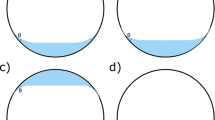Abstract
Complications during the intraocular use of silicone oil can be caused by two factors: first, mechanical interaction with the surrounding tissue and, second, the physicochemical properties of the oil itself. The properties of 14 oils of various origins in clinical use were investigated: 12 of the 14 oils contained various amounts of low-molecular-weight components (cyclosiloxanes and molecules with a molecular weight of less than 2400), which are able to diffuse into the surrounding tissue and may incite toxic or inflammatory reactions. Some of the samples had a tenfold lower volume resistivity than others, an indicator of the presence of ionic impurities, such as catalyst remnants, which may also be responsible for adverse reactions.
Similar content being viewed by others
References
Ando F (1985) Intraocular hypertension resulting from pupillary block by silicone oil. Am J Ophthalmol 99:87–88
Blodi FC (1971) Injection and impregnation of liquid silicone into ocular tissues. Am J Ophthalmol 71:1044–1051
Cibis PA, Becker B, Okun E (1962) The use of liquid silicone in retinal detachment surgery. Arch Ophthalmol 68:590–599
Kampik A, Gabel VP, Spiegel D (1984) Intraokulare Tamponade mit hochviskösem Siliconöl bei massiver proliverativer Vitreo-Retinopathie (PVR). Klin Monatsbl Augenheilkd 185:368
Ni C, Wang WJ, Albert DM, Schepens C (1983) Intravitreous silicone injection; histopathologic findings in a human eye after 12 years. Arch Ophthalmol 101:1399–1401
Okun E (1976) The current status of silicone oil: analysis of long-term successes. In: Irvine AR, O'Malley C (eds) Advances in vitreous surgery. Charles C. Thomas, Springfield, pp 518
Refojo MF, Roldan M, Leong F, Henriquez AS (1985) Effect of silicone oil on the cornea. J Biomed Mater Res 19:643–652
Rentsch FJ, Ayler P, Liesenhoff M (1977) Histologische und elektronenmikroskopische Untersuchungen an einem menschlichen Auge nach mehrjähriger intravitrealer Siliconimplantation. Ber Zusammenkunft Dtsch Ophthalmol Ges 75:70–74
Scott JD (1979) A rationale for the use of liquid silicone in retinal detachment surgery. Excerpta Med 1:433–437
Scott JD (1981) Use of liquid silicone in vitrectomized eyes. Dev Ophthalmol 2:185–190
Sugar HS, Okamura ID (1976) Ocular findings 6 years after intravitreal silicone injection. Arch Ophthalmol 94:612–615
Watzke RC (1967) Silicone retinopiesis for retinal detachment: a long-term clinical evaluation. Arch Ophthalmol 77:185–196
Zivojnovic R, Mertens CAE, Peperkamp E (1982) Das flüssige Silikon in der Amotiochirurgie. Klin Monatsbl Augenheilkd 181:444–448
Author information
Authors and Affiliations
Rights and permissions
About this article
Cite this article
Gabel, V.P., Kampik, A. & Burkhardt, J. Analysis of intraocularly applied silicone oils of various origins. Graefe's Arch Clin Exp Ophthalmol 225, 160–162 (1987). https://doi.org/10.1007/BF02175441
Received:
Accepted:
Issue Date:
DOI: https://doi.org/10.1007/BF02175441




